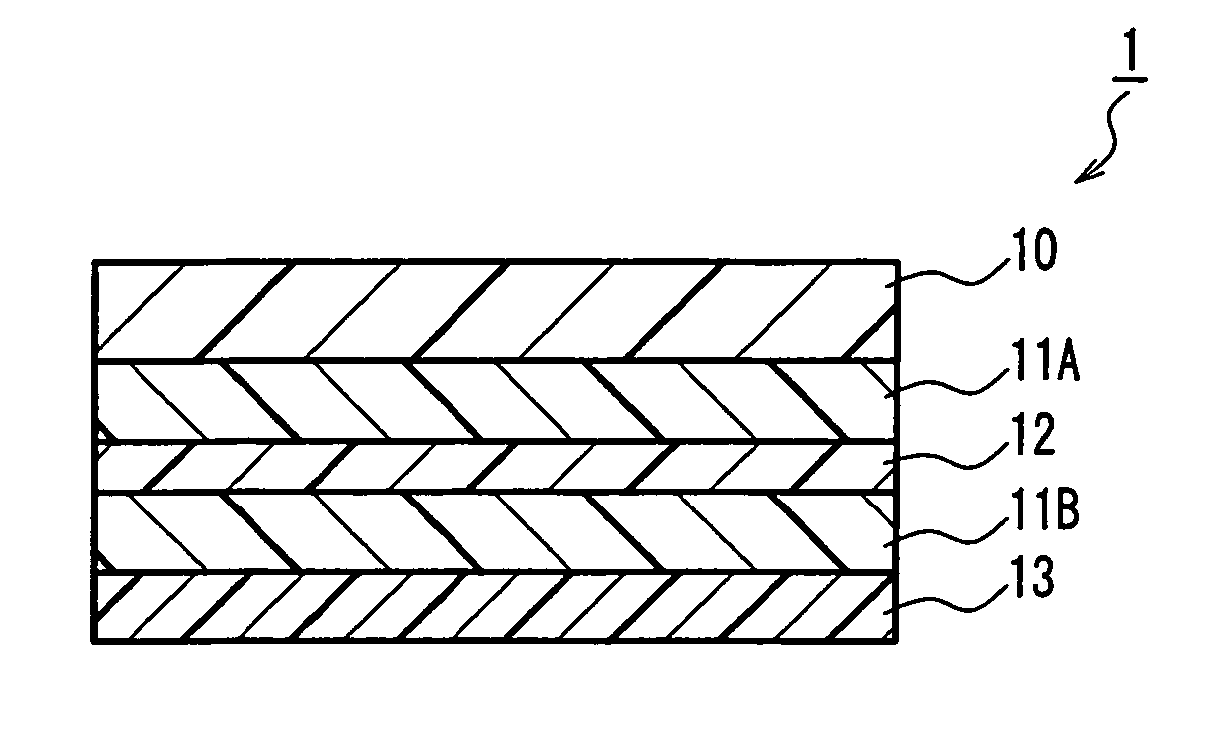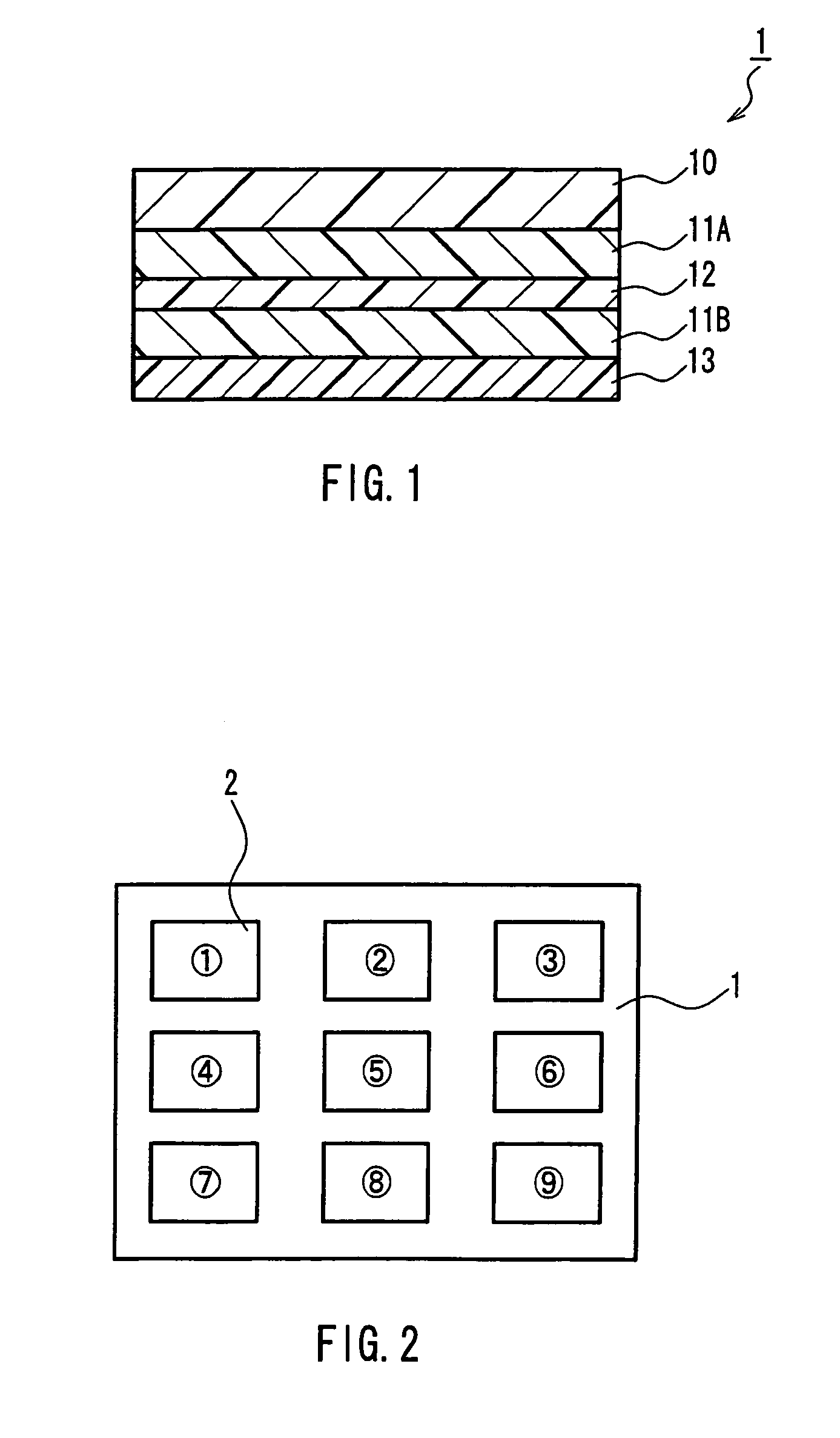Polarization plate with optical compensation layer and image display device
a technology of optical compensation layer and polarizing plate, which is applied in the direction of polarizing elements, non-linear optics, instruments, etc., can solve the problems of affecting the reattachment of the polarizing plate with the optical compensation layer, and breaking the optical compensation layer and the liquid crystal display panel, etc., to achieve the effect of sufficient adhesiveness and easy reattachmen
- Summary
- Abstract
- Description
- Claims
- Application Information
AI Technical Summary
Benefits of technology
Problems solved by technology
Method used
Image
Examples
example 1
[0175]On a 50 μm thick triacetylcellulose (TAC) film (manufactured by Fuji Photo Film Co., Ltd.; trade name:T-50SH), 1 wt % PVA (manufactured by The Nippon Synthetic Chemical Industry Co., Ltd.; trade name: NH-18) aqueous solution was applied and dried at 90° C., thus forming a PVA coating having a thickness of equal to or smaller than about 0.01 μm. Then, a surface of this coating was rubbed so as to form an alignment film. On the other hand, a liquid crystal monomer represented by the formula (6) above (a polymerized rod-like nematic liquid crystal) and a chiral dopant represented by the formula (44) above were mixed such that the weight ratio between them were 7:3. This mixture was dissolved in toluene so as to obtain 40 wt % solution. Furthermore, a photopolymerization initiator (trade name: IRGACURE; manufactured by Ciba Specialty Chemicals) was added so as to account for 3 wt %, thereby preparing a coating solution. The coating solution was applied to the alignment film and su...
example 2
[0181]A polarizing plate with an optical compensation layer was obtained similarly to Example 1 above except for using as the pressure-sensitive adhesive (B) a pressure-sensitive adhesive solution (15 wt % toluene solution) prepared by adding 0.8 parts by weight of a cross-linking agent (polyfunctional isocyanate compound; manufactured by NIPPON POLYURETHANE INDUSTRY CO., LTD.) to 100 parts by weight (solids) of an acrylic polymer. The acrylic polymer had a weight ratio of butylacrylate / acrylic acid=100 / 3, a weight-average molecular weight of 1,500,000 and a glass transition temperature of −33° C.
examples 3 to 5 and reference example
[0198]A polarizing plate with an optical compensation layer (300 mm×250 mm) in which the release film was formed on an exposed surface of the pressure-sensitive adhesive layer (B) was produced similarly to Example 1 above except that a commercially available polarizing plate (manufactured by Nitto Denko Corporation; trade name: SEG5224DU) was subjected to a heat treatment at a predetermined temperature for a predetermined period. The heating condition is shown in Table 2 below. Then, the release film was peeled off from the polarizing plate with the optical compensation layer. Via the exposed pressure-sensitive adhesive layer (B), the polarizing plate with the optical compensation layer was attached by roller onto a glass substrate (400 mm×400 mm). Thereafter, an untreated polarizing plate (manufactured by Nitto Denko Corporation; trade name:SEG5224DU) was further attached to the backside of the glass substrate in a crossed Nichols state using a pressure-sensitive adhesive. Using th...
PUM
| Property | Measurement | Unit |
|---|---|---|
| adhesive strength | aaaaa | aaaaa |
| adhesive strength | aaaaa | aaaaa |
| glass transition temperature | aaaaa | aaaaa |
Abstract
Description
Claims
Application Information
 Login to View More
Login to View More - R&D
- Intellectual Property
- Life Sciences
- Materials
- Tech Scout
- Unparalleled Data Quality
- Higher Quality Content
- 60% Fewer Hallucinations
Browse by: Latest US Patents, China's latest patents, Technical Efficacy Thesaurus, Application Domain, Technology Topic, Popular Technical Reports.
© 2025 PatSnap. All rights reserved.Legal|Privacy policy|Modern Slavery Act Transparency Statement|Sitemap|About US| Contact US: help@patsnap.com



